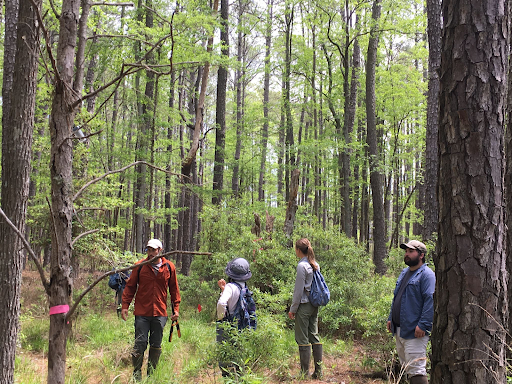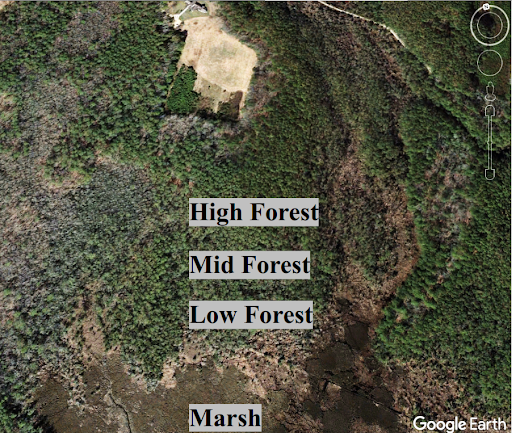—by Ezra Jay Kottler (@ejkottler)
The air is thick with humidity and the buzz of insects as we clamber out of two lab vans on a morning in late June. We are visiting the Virginia Coast Reserve, a protected area that extends across one of the last undeveloped stretches of Atlantic coastline left in the United States Mid-Atlantic region. Despite the heat, we are covered from head to toe and are equipped with muck boots, mosquito nets and a generous spray of insect repellant. Our team is a fresh crop of scientists, consisting of two PhD students, a lab technician and two undergraduate students in the Research Experience for Undergraduates (REU) program. Ready to tackle the elements and collect data, we gather our equipment in buckets and a wheelbarrow and tote them along the trail that leads to the forest dieback experiment: the newest long-term experiment at the Virginia Coast Reserve LTER site.

Researchers working at the forest disturbance site, Nassawadox VA.
Credit: Cora Johnston-Baird CC BY-SA 4.0
The Effect of Sea Level Rise
These scientists have begun extensive monitoring of the environmental conditions in a series of forest dieback “zones”: the high forest zone in which a variety of tree species are still healthy and growing; the mid forest zone where only pine and cedar trees can tolerate the salty ground water; and the low forest zone where 20-40% of trees have died due to the impacts of sea level rise and coastal storms. This design allows scientists to study the effects of current marsh migration and projected future dieback, with physical space as a proxy for change over time.

Aerial photograph of Brownsville Preserve, VA, with forest zones labeled
Credit: Google Earth
After a fifteen-minute walk through the forest, we reach our plots. Today, we are surveying the forest vegetation, marking our third year of observations on the annual cycles in these zones. In the future, our research team will be girdling all trees in half of the plots in each zone – a change that mimics the tree mortality that would occur during an extreme storm event. That way we will be able to see how tree mortality impacts the process of marsh migration.
Capturing Rapid Forest Changes
Even before the girdling, trees are falling right and left in this forest. “We totally underestimated how fast the changes in the forest are occurring, even without an experimental disturbance event.” says co-PI Dr. Matt Kirwan. “When I visit a site once a year or so, it sort of looks all the same to me. Dead trees here, marsh there, and a band of stressed trees in between. But now that we’re visiting the site more often, and have set up permanent plots and instruments, the changes are just so much more obvious. The whole point of the experiment was to try and induce state changes through disturbance, but we’re seeing them play out almost every time we go in the field.”
This day’s trip into the field is no exception to Dr. Kirwan’s observations. We are walking across parallel transects in plots, measuring the abundance of shrubs in both native and invasive marsh grasses. As I follow the orange cord that runs 20 meters between adjacent plot corners, it suddenly disappears, crushed under a fallen pine trunk.

Dead fallen pine tree crushing a leaf litter trap.
Credit: Keryn Gedan CC BY-SA 4.0
We finish transects through our 8 plots in the high forest and move on to the mid forest. Here the dense vegetation makes it impossible to see the far edge of the plot and run a straight transect. So, we adapt: one of our team measures the correct distance on the far side and the transect runner approaches them, guided by sound. Sometimes it’s a call and response of “Marco” “Polo”, sometimes a monologue from my community theatre background.
Coastal Storms and Adaptability
As we break for lunch under the shade of the high forest canopy, the sky begins to darken. We can hear the wind gusting through the forest canopy. Suddenly two of our colleagues run in from the marsh. “The wind’s picking up, maybe 15mph. It’s not safe out there, we need to get out!” Knowing the danger of treefall in this tenuous transition system, we pick up our buckets and wheelbarrow and make a speedy retreat to the vans. Just as we manage to fit the wheelbarrow and supplies in like a game of Tetris, the rain starts pouring down. Wet but buzzing with the energy of the morning, we drive back to the station. Limited by the weather, we shift our afternoon work plans and train the REU students to use the leaf area index meter so that they can measure the plant canopy the following week.
Like our day in the field, building a long-term experiment requires the ability to adapt and respond to changing conditions. “As we observed natural changes at our research site, we chose to delay some research activities to collect more baseline data prior to implementing an experimental treatment. The setting and long grant cycle of the LTER gave us the flexibility to adapt our plan without sacrificing our overall progress on our scientific research aims.” says co-PI Dr. Keryn Gedan. At the same time, the temporal scale of the project does impose certain restrictions, as co-PI Dr. Sergio Fagherazzi points out: “In a long-term experiment you have less flexibility, because you want to measure the same parameters for a long period. The challenge is to find a set of measurements that can be repeated for so many years without becoming too labor intensive.” The balance between consistent measurements and adaptability as you learn more about the system and as your questions shift is quite a tightrope to walk.
But despite the challenges, there is an overwhelming sense of excitement shared by the whole team as we work to capture the facets of these shifting coastal habitats. “Although physically demanding and sometimes tiring, being out in the forest is really rewarding and honestly, fun.” Says REU scientist Rheya Sward. “Walking through all of the plots and seeing the different equipment that has been set up is a really fun process because I feel like I hear about stuff like that in school and books but seeing the actual process of research being done in front of me is very different!” The rewards of long-term research are the depth of investigation one is able to explore. “I’m excited to learn more about the processes and feedbacks driving these changes.” says Dr. Kirwan. “As a community, we’ve done a good job at quantifying rates and spatial extents of marsh migration into uplands. But we’ve only scratched the surface as to the mechanisms that determine those changes.” This experiment can help to piece together driving mechanisms of marsh migration, informing the larger understanding of sea level rise and coastal habitat migration across regions.










